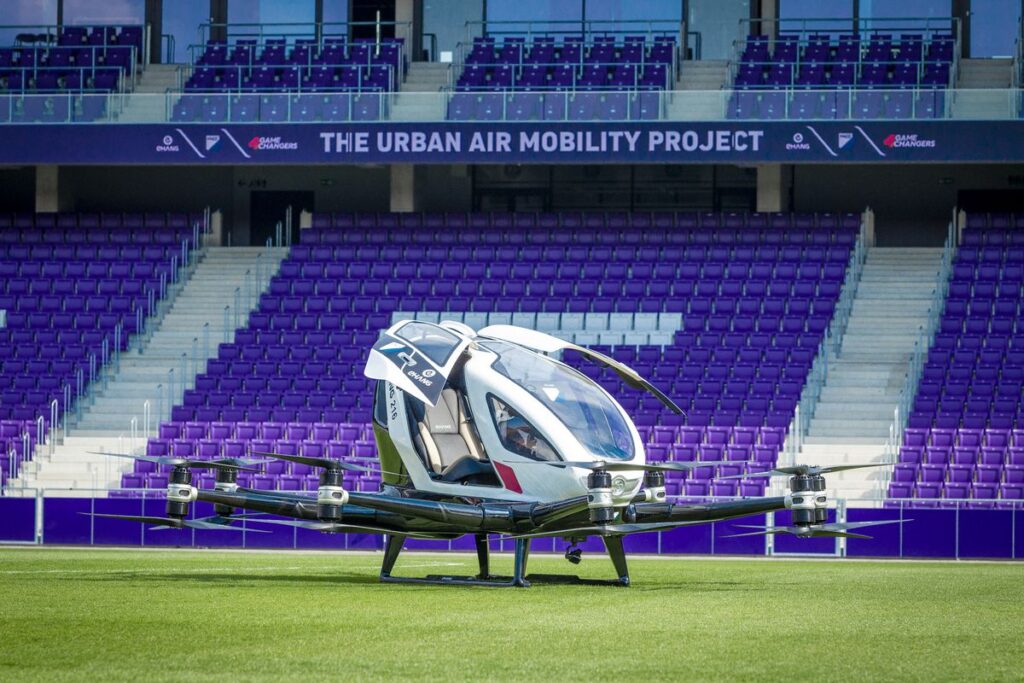The world of taxi drones has long been an idea of the future, but when will it become a reality? Despite initial excitement and investments from companies like Ehang, Uber Elevate, and Airbus, progress on implementing passenger drones has been slow. However, recent developments suggest that the dream of flying taxis may not be too far away. Lilium, Hyundai, and Airbus have all made significant investments in the creation of taxi drone hubs and testing infrastructure. With plans for test flights, the construction of transportation hubs, and commercial launches in the next few years, it seems that taxi drones may finally be taking flight sooner than we think.
Companies Are Betting on Taxi Drones—But When Will They Take Flight?
Lilium, Hyundai, and Airbus Are All Betting Big on Taxi Drones
In recent years, companies like Lilium, Hyundai, and Airbus have made significant investments in the development of taxi drones. These companies are placing big bets on the future of urban air mobility and are working towards making taxi drones a reality. While progress has been made, the question remains: when will taxi drones actually take flight?
A Look Back at Progress on Passenger Drones
Back in 2017, there was significant excitement and optimism surrounding the potential implementation of passenger drones. Companies like Ehang, Uber Elevate, and Airbus were heavily investing in the technology, and cities around the world were preparing for the advent of taxi drones. However, since then, progress has been slower than expected. Dubai’s drone taxi program, which was supposed to launch in 2017, never took off, and there are still no cities that have fully implemented passenger drones. Despite this, there have been important developments that suggest progress is still being made.

Recent Developments in Taxi Drone Technology
In recent months, there have been several major developments in the field of taxi drone technology. Lilium, a German drone taxi startup, announced plans to build a $25 million vertiport hub in Orlando, Florida. This hub will serve as a transportation center for Lilium’s electric five-seater drone taxis. The company aims to have its drone taxi service operational by 2025. Another major player, Hyundai, has partnered with the U.K. to create a test site for taxi drones. The site, called Air One, will focus on testing and developing the infrastructure needed to support the use of passenger drones. These developments demonstrate a commitment to advancing taxi drone technology and suggest that companies are serious about bringing this mode of transportation to the public.
Quick Definitions of Important Terms
Before we delve further into the topic of taxi drones, let’s define some important terms. Urban Air Mobility (UAM) refers to the use of unmanned vehicles, primarily taxi drones, in urban and suburban areas. Advanced Air Mobility (AAM) expands on UAM and includes the use of unmanned vehicles in non-urban environments. Electric Vertical Takeoff and Landing (eVTOL) is the technology being developed for taxi drones, which allows for vertical takeoff and landing in congested urban environments.

Lilium Plans $25 Million Vertiport Hub in Orlando
Lilium’s plans to build a $25 million vertiport hub in Orlando, Florida, are a significant step towards making taxi drones a reality. The hub will serve as a transportation center for Lilium’s electric five-seater drone taxis, which are expected to be operational by 2025. This investment demonstrates Lilium’s commitment to developing the infrastructure needed to support widespread use of taxi drones. The city of Orlando has shown its support for this project by providing Lilium with tax breaks, further mitigating the company’s financial risk. While regulatory approval is still pending, Lilium’s substantial funding and capital put it in a strong position to move forward with its plans.
Hyundai Partners with the U.K. to Create UAM Test Site
Hyundai’s partnership with the U.K. to create the Air One test site showcases the company’s dedication to the development of taxi drones. The test site will focus on testing passenger drones and building the necessary infrastructure to support their use. Hyundai’s Urban Air Mobility Division believes that UAM is not only convenient but also crucial for reducing our carbon footprint. The company has pledged to create 200 zero-emission sites worldwide over the next five years. This partnership and investment highlight Hyundai’s commitment to sustainable transportation solutions.

EU Plans Intensive UAM Testing Over Next Two Years
The European Union has launched a major project called Air Mobility Urban—Large Experimental Demonstration (AMU-LED), which aims to test taxi drones and other UAM technology. This project involves 17 different companies, including Boeing, Airbus, and Ehang. Over the next two years, these companies will conduct UAM tests in Spain, the U.K., and the Netherlands. The goal is to complete over 100 hours of test flights, showcasing the reliability of UAM technology for various applications such as air taxis, cargo transport, and emergency services support. The EU’s commitment to intensive UAM testing is a promising sign for the future of taxi drones.
Timeline for the Availability of Taxi Drones
While progress is being made in the development of taxi drones, there is still a considerable timeline before they become widely available. The EU plans to complete over 100 hours of test flights for UAM by 2023. Lilium aims to launch regular drone taxi flights by 2025, with a focus on the Orlando area. Urban Air Port plans to build 200 UAM Air Port sites by 2026, further supporting the infrastructure for taxi drones. Hyundai plans to commercially launch its taxi drones by 2028. However, it’s important to note that these timelines are subject to regulatory approval, which is currently lacking. Realistically, it may take another ten years or more before taxi drones become a common sight in cities around the world.

The Future of Taxi Drones
Despite the challenges and timeline for availability, the future of taxi drones looks promising. The investments and commitments made by companies like Lilium, Hyundai, and Airbus demonstrate a genuine belief in the potential of taxi drones. These companies are betting big on the future of urban air mobility and are actively working towards making it a reality. As technology continues to evolve and regulatory frameworks are established, the viability and acceptance of taxi drones will become clearer. The potential benefits, such as reduced congestion and carbon emissions, make taxi drones an attractive solution for urban transportation. However, it remains to be seen how quickly they will be adopted and integrated into existing transportation systems.
Conclusion
In conclusion, companies like Lilium, Hyundai, and Airbus are making significant investments in the development of taxi drones. These investments are paving the way for the future of urban air mobility and hold the potential to revolutionize transportation as we know it. While progress has been slower than expected, recent developments in taxi drone technology, such as Lilium’s vertiport hub in Orlando and Hyundai’s partnership with the U.K., demonstrate a commitment to moving forward. The timeline for the availability of taxi drones is still uncertain, but with continued advancements and regulatory support, we may see them become a reality within the next decade. The future of taxi drones is on the horizon, and it’s an exciting time to witness the evolution of transportation.


